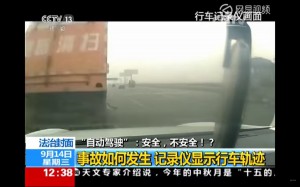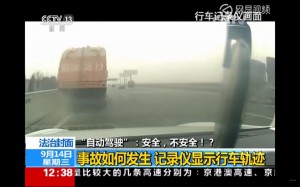
Dash cam footage chronicles the second fatal crash involving Tesla's Autopilot program. This one was in China in January. Photo credit: Jalopnik.
A second fatal crash, this one in China, may have been the result of a malfunction by Tesla’s semi-autonomous Autopilot system.
The incident, which occurred last January but is only now being revealed, took the life of 23-year-old Gao Yaning, the son of the Model S owner. A video captured by a dash camera mounted in the car showed that it appeared to hit a street sweeper at highway speeds, rather than moving aside.
The crash preceded a May 9 collision between a Model S operating in autonomous mode and a truck that turned into the battery-car’s path. Tesla confirmed the Autopilot system was operating when that accident, which took the life of a 40-year-old former Navy SEAL, occurred on a Florida highway. Because of the extent of the damage in the China crash, Tesla says there is “no way of knowing” if the system was enabled.
Either way, the fatal wreck focuses even more attention on Tesla’s controversial technology and, indeed, on autonomous systems more broadly. The revelation comes at a time when automakers around the world are ramping up their efforts to develop self-driving vehicles and even more advanced driverless cars. Ford Motor Co. last month said it would begin building vehicles that need no driver or backup “operator” by 2021, initially focusing on ride-sharing and delivery services.
Less advanced semi-autonomous products, some capable of brief hands-free operation, are already on the road. That includes the 2017 remake of the Mercedes-Benz E-Class and Tesla Models S and X equipped with Autopilot mode.
(Tesla updating Autopilot within two weeks. Click Here for story.)

The family of the driver of this Model S involved in this fatal crash while using Autopilot is suing Tesla. Photo credit: Jalopnik.
Officially, the California battery-carmaker tells owners that Autopilot is an advanced driver assistance system, or ADAS in industry lingo. But critics have warned that the maker has also over-hyped the capabilities of the system, leading many to believe it can operate for long periods without driver intervention. Indeed, there is some indication that when Joshua Brown’s vehicle was involved in the Florida crash, he may have been watching a video on his laptop computer.
Tesla itself has sent some mixed signals about what occurred. What is known is that both Autopilot and Brown failed to recognize the semi-truck that turned into the path of his Model S. The system’s camera apparently confused the white trailer for a bright Florida sky while its radar system thought the truck was an overhead sign.
Tesla CEO Elon Musk last week said the carmaker will shortly enable new software that will be able to better recognize obstacles using the onboard radar system, a “dramatic improvement” that would have likely prevented the Florida crash.
Several industry insiders with experience in autonomous vehicle development who agreed to talk to TheDetroitBureau.com raised concerns about the update, particularly its primary dependence on just the onboard radar system. “You need a sensor fusion, not just one system, to avoid mistakes,” said a high-ranking Detroit engineering executive.
(Click Here for more about Tesla’s claim that European crash didn’t involve Autopilot.)
Google, Ford and even Uber – which showed off its autonomous prototype this week – rely on cameras, radar and laser-based LIDAR systems that can provide a highly detailed view of the world around a vehicle. The signals and images are cross-checked to minimize error.
At least two other Tesla crashes have been blamed by their owners on Autopilot malfunctions, though Tesla has said that its automatic reporting system showed the system was not operating on either vehicle when they were wrecked. Tesla vehicles are equipped with two-way communications systems that can download software updates and which also upload information about how the vehicles are being driven.
The Chinese crash was first reported this week by China’s CCTV and later picked up by the Reuters news service. Driver Gao’s family apparently filed suit against Tesla in July. The maker said it has “tried repeatedly” to work with the family to determine what happened. So far, the family has declined to cooperate.
The online auto site Jalopnik, meanwhile, posted a video reportedly taken by Gao’s dash camera. It shows his Model S racing along a highway in a light fog, but the street sweeper was still visible, taking up a portion of the sedan’s lane. Instead of swerving or slowing down, the Tesla slammed into the truck at full highway speed.
(Tesla looks to upgrade controversial Autopilot program. Click Here for the story.)
Tesla isn’t the only automaker to experience a crash with a vehicle using some form of driver assistance or autonomous technology. Google, in fact, has reported more than a dozen incidents, most of them fender-benders. Only one minor injury was reported, and only one of the crashes was actually blamed on the Google prototype.
